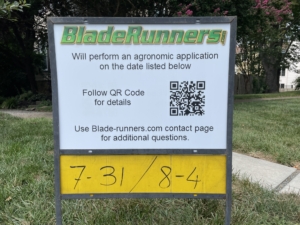Blade Runners Approach: Posting Agronomic Signs
While this requirement for Associations (§ 55-510.3 )may produce added expense for the association it really is a good idea. This effective communication to your residents, communicates service dates, the QR Code provides and takes residents instantly to the Blade Runners Resource Book. This has all the support documentation of pesticide products to be applied, along with MSDS sheets, product labels, product toxicity info (if any), mixture rates and contact information should they have further concerns. 
Blade Runners has long provided this pesticide sign posting service option for our Homeowner Associations, Condominium Associations and Commercial Sites. This not just littering the community with pesticide application flags vaguely communicating the ‘something’ was applied.
We provide highly visible, solid real estate-style signs placed at specific areas of the property. It contains the dates of application along with the QR Code Link to our resource book and a way to contact Blade Runners with questions.
Proper implementation for both pesticide notice posting and the agronomic applications takes planning. Adequate inventories of signs are needed to replace weathered and/or stolen signs. Coordination planning is necessary in order to time the application after a turf mowing for maximum control along with the required 48 hour advance posting visit to place the signs. In the event of poor weather, an additional visit might be needed to alter the date. Signs are removed from the site after the application.
As with many things there is more to this than meets the eye. Associations should be careful that there solution is a comprehensive one that adds value. Turn this annoyance into a positive thing for your community!
See our Famous Blade Runners Resource Book Here–> Click Here-Blade Runners Resource Book Here!
Blade Runners QR Code Link to Resource Book on Sign contains:
- Product label and MSDS sheets for all products we use.
- Phone numbers for state and government agencies should the client want addition information.
- Questions and answers regarding the service & Our methods of production and the manner in which we deliver the service.
- Blade Runners Agronomic Program Details – with Product Names, Timeline, Mixture Rates.
- Blade Runners Philosophy “SAFE” Program.
- S- Safety
- A- Accreditation
- F- Facts
- E- Education
Read all about Virginia Property Owners’ Association Act requirements for new notice of pesticide application
Virginia HOA Boards, and Property Managers, and landscape contractors were blindsided by a Virginia Statute (§ 55-510.3 ) requiring 48 hours of posting notice for all agronomic applications.
Read the actual statue § 55-510.3. Common areas; notice of pesticide application. The association shall post notice of all pesticide applications in or upon the common areas. Such notice shall consist of conspicuous signs placed in or upon the common areas where the pesticide will be applied at least 48 hours prior to the application



